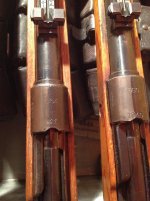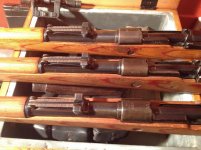I have a serious weakness for Norwegian captured K98k's. I've read stories that the Norwegian Armed Forces picked only guns from the best production years and dumped the rest into the sea.
A fair amount of rifles in my collection of mostly de-activated K98's are Norwegian. Although pretty much all of them are converted post-war to 7,62x63/.30-06, most of those "M98k F1's" carry a beautiful (pre/early-war) stock original to the action with all german markings left intact. Some of them have a non matching (or forced matching) bolt or perhaps a different boltstop, but in most cases the stock, action, magazine, bands, buttplates and even the capture screws appear to be all matching.
My latest catch is a 1940 660 from a-block with G.29/40 on the siderail. Apart from the darkblue-ish metal and the renumbered bolthandle to match the HÆR s/n that is also present on the buttplate i'm totally amazed by the way it is preserved.
Is it because of the type of varnish that was used by the Norwegians that their stocks look so stunningly beautiful after all those years? Has the varnish got anything to do with the light tint of laminate or was it pure storingconditions?
None of the Norwegians in my collection have a flattened receiver. All appear to be "welded" receivers that were once flat and someone did a good job preserving the factorycode, s/n + block and even the birds after machining the receivers round again. Does anyone know where or by who the "retoring" of those receivers was done? They all appear to be done in an identical way.
A fair amount of rifles in my collection of mostly de-activated K98's are Norwegian. Although pretty much all of them are converted post-war to 7,62x63/.30-06, most of those "M98k F1's" carry a beautiful (pre/early-war) stock original to the action with all german markings left intact. Some of them have a non matching (or forced matching) bolt or perhaps a different boltstop, but in most cases the stock, action, magazine, bands, buttplates and even the capture screws appear to be all matching.
My latest catch is a 1940 660 from a-block with G.29/40 on the siderail. Apart from the darkblue-ish metal and the renumbered bolthandle to match the HÆR s/n that is also present on the buttplate i'm totally amazed by the way it is preserved.
Is it because of the type of varnish that was used by the Norwegians that their stocks look so stunningly beautiful after all those years? Has the varnish got anything to do with the light tint of laminate or was it pure storingconditions?
None of the Norwegians in my collection have a flattened receiver. All appear to be "welded" receivers that were once flat and someone did a good job preserving the factorycode, s/n + block and even the birds after machining the receivers round again. Does anyone know where or by who the "retoring" of those receivers was done? They all appear to be done in an identical way.


